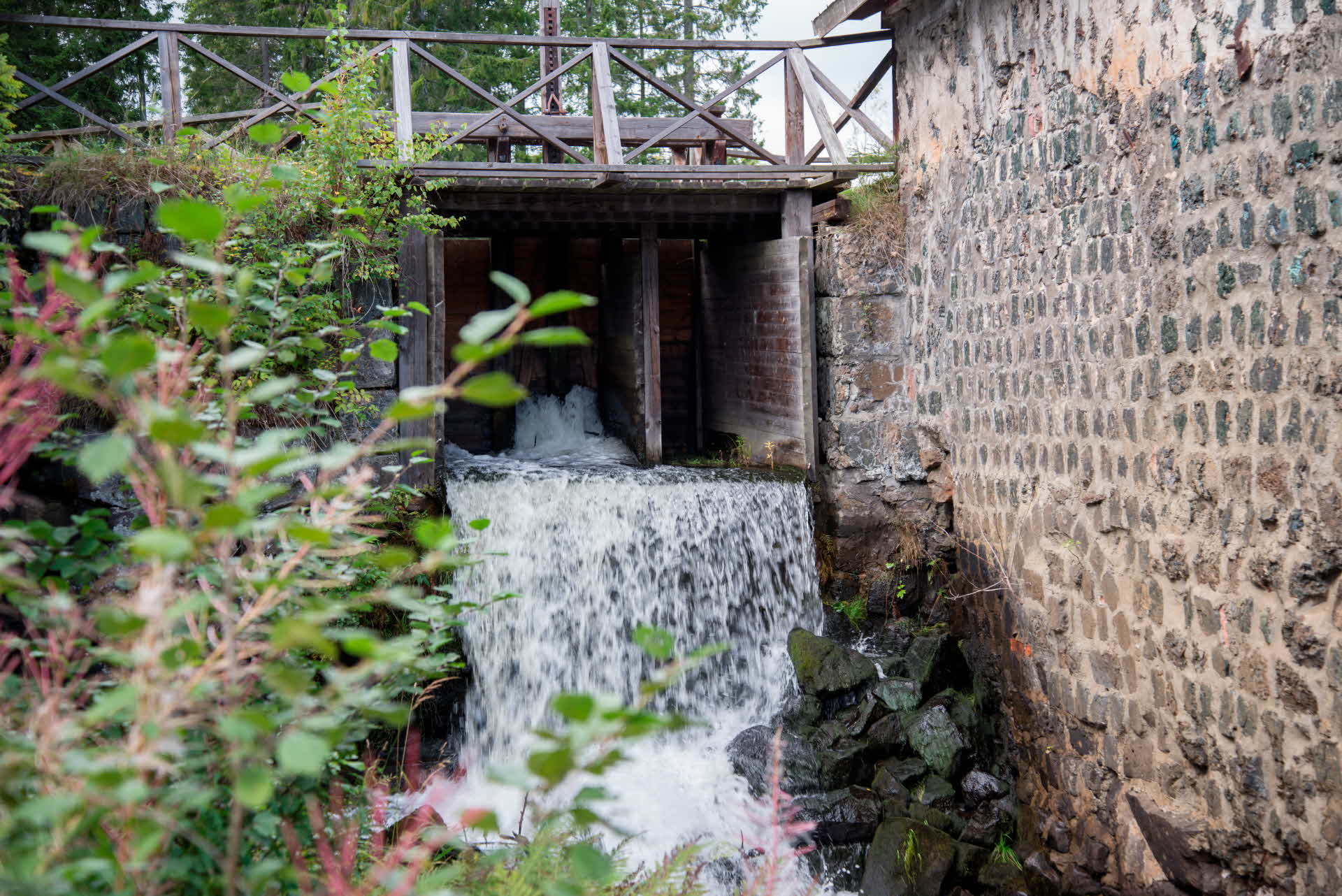
The dams
There are six dams in the Galtström area (Ålhusdammen, Kvarndammen, Sågdammen, Hammardammen, Kyrkdammen and Bruksdammen) that regulate the water flow in the Armsjö River. The aim of the dams was to use the energy from the falling water to drive the water wheels and turbines that powered all of the ironworks’ machinery.
The women used Kyrkdammen for washing, and eel were caught in Ålhusdammen. All of the dams served a purpose.
Eel was and is very popular food. Eels migrate up the river system from the sea. An eel trap in the Armsjö River dates back to the 17th century – probably even further back. The eel house in Ålhusdammen is a modern reconstruction. Ålhusdammen has plinths of building timber filled with stones and five floodgates. For eel fishing, the floodgate to the water chute that runs into the eel house was opened. The current had to be so strong that the fish in the chute couldn’t swim upstream, but were carried down to the eel house. The eels where trapped in a grid of tightly spaced slats. The floodgate was closed before emptying the trap, and the eels were then scooped up with a net. The slats in the reconstructed version however are so widely spaced that the now endangered eel can swim through them.
Kvarndammen
Flour was the basic ingredient of the food eaten by the Galtström families. Coarse bread, as well as crispbread and flatbread, were made from rye and barley flour. The flour was also used to make porridge and gruel, which were eaten every day. The mill was therefore an important link between the farm, the bakery and the home. The mill had two millstones where the rotating action of the runnerstone was driven by the effect of water flowing over a cast iron turbine on a vertical axis. The chimney you can see belongs to the stove, which heated the miller’s “office” in the mill. The mill was built in the 1850s. It has been restored to running condition. The former miller’s residence next door is now a private summerhouse.
Sågdammen
There was a water-powered sawmill with two frames at the works from the very beginning. It stood next to the upper trip hammer and took its power from Hammardammen. A new sawmill was later installed upstream beside a new dam, now known as Sågdammen. The boards and planks made by the sawmill were mainly used for the ironworks’ own construction. Later on, some of the production was sold in the area. The original sawmill at Hammardammen was left untouched by the Russian Pillage in 1721 and was rebuilt to increase capacity in 1744. In the mid-1800s, two more water-powered sawmills were installed further up the Armsjö River. Neither of these sawmills were in operation for very long, and both were soon closed down. The sawmill at Sågdammen was connected to the port by rail, where sawn timber was laid up on staves to dry. The Armsjö River was used for log driving, and logs were stored in the dam. There was a log hoist by the dam that was used to lift the logs. The sawmill was powered by a turbine and driven by water power. The remains of the sawmill include foundation ruins downstream of the dam and a large sawdust pile on the southern banks of the river.
The sawmill cut its last log on June 2, 1919.
Hammardammen
There have been two wrought iron hammers at Galtström with related fining hearths. The lower trip hammer with two fining hearths was installed when the ironworks were founded and placed adjacent to the center of the works. Shortly after, the upper trip hammer and Hammardammen were installed. The second fining hearth was installed in 1779, and was later converted to a Franche-Comté finery with two hearths and two trip hammers in the 1860s. In 1877, four Lancashire fining hearths, one mumbling trip hammer and a rolling mill were installed. The trip hammer, rolling mill and air blast were driven by water power and continued to operate until 1903. The entire complex was called Galtström’s forge and rolling mill. The dam, a clinker block wall, the channel for the water wheel and turbines are still standing today. A pile of bricks to the right of the channel shows where the drying building and chimney stood. The remains of the forge’s large charcoal storage magazine can be seen near the road.